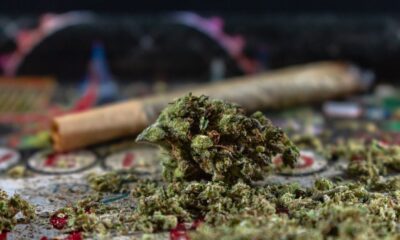Cannabis
Illegal Cannabis Market in Canada Gains Significant Ground, Report Shows
After the initial phase marked by unbridled optimism, it all turns out to be quite difficult to eradicate the illegal cannabis trade. The share of sales of legal cannabis products by so-called licensed producers in Ontario fell from 74.2% in July 2019 to 60.8% in April 2022. Still not bad, of course, to have a 60 percent market share after four years, but the downward trend is troubling.

Adult-use cannabis sales in Canada are in the weeds,” several Canadian newspapers wrote last weekend. An Ernst & Young report shows that the black market in Canada has risen substantially again in recent years, and thus the share of legal cannabis sales is falling.
Read more about the cannabis market in Canada and find the latest cannabis news from around the world with the hemp.im mobile app.
Europe should learn from Canada’s experience
Because Canada was the first major Western country – in October 2018 – to legalize recreational cannabis in one fell swoop, the lessons learned there are also important for other countries considering legalization. Among the European countries that have plans to legalize cannabis are Germany, Switzerland, Malta, Luxembourg, the Czech Republic, for example, and soon the Netherlands and Belgium as well.
After the initial phase marked by unbridled optimism, it all turns out to be quite difficult to eradicate the illegal cannabis trade. And that is invariably something that is seen as a very important objective of the legalization of recreational cannabis, even by the authorities themselves. What’s going on in Canada?
Market share of legal cannabis down 13.4% since 2019
So first of all, the report from the accounting firm Ernst & Young, which was made on behalf of the Cannabis Council of Canada, focuses on the province of Ontario, the most populous (over 12 million people) region in Canada that includes the metropolis of Toronto. But the problems outlined apply to all of Canada since illegal market players obviously won’t be stopped by any artificial (land) border.
The share of sales of legal cannabis products by so-called licensed producers in Ontario fell from 74.2% in July 2019 to 60.8% in April 2022. Still not bad, of course, to have a 60 percent market share after four years, but the downward trend is troubling.
Three solutions for the struggling legal cannabis industry in Canada
The report, therefore, pays close attention to regulations and taxes related to cannabis. “These raise questions about the viability of the industry if the government does not help the industry find solutions,” Ernst & Young said.
Thus, prominent among the suggestions listed to make the legal cannabis trade fruitful is the reduction and harmonization of provincial and national excise tax rates. It is also important to launch awareness campaigns that educate the public about the risks of unregulated products and to crack down(er) on illegal sales.
The legalization of recreational cannabis in the fall of 2018 aimed to exclude young people from accessing cannabis, protect public health by providing adults with safe cannabis products, and keep criminals out of the mix.
Low(er) prices won’t save the legal cannabis industry
However, the current report states that currently- with the expansion of the industry – optimism is beginning to evaporate and the illicit trade continues to flourish, depriving the legal industry of revenue. “No one could have predicted the onset of a global pandemic and the impact corona would have on physical stores,” the report states.
“But the root cause is essentially a playing field that is heavily tilted in favor of an illegal market. Legal producers and sellers must comply with a multitude of government regulations and pay taxes at both the federal and provincial levels – rules that illegal players don’t work with.”
The Ernst & Young report also describes what the consequences of this have been in Canada. “The legal industry has adapted in multiple ways to remain competitive. Producers have rationalized their operations to gain efficiency and lowered their prices to attract consumers. But that has left many struggling with profitability, with some pushed to the brink of bankruptcy. Price compression, however, does not have nearly the same effect on government revenue since most taxes on cannabis are based on volume, not price.”
Second report: growth of legal cannabis sales disappointing
The bleak climate in Canada’s legal cannabis business is also underscored by a second current report, reported by the website MJBizzDaily with the article “Canadian adult-use cannabis sales growth slowing faster than expected.
The report was written by analyst Frederico Gomes of ATB Capital Markets and it calls for “necessary and structural changes to restore growth momentum.” Growth in legal cannabis sales was only 7.7% year-on-year in September 2022, which is the lowest growth rate since legalization in October 2018!
Too low prices, massive overproduction, and the tax again
Causes for the malaise in the legal cannabis industry according to this report:
Government-owned businesses – particularly wholesalers – generate the only meaningful profit in the industry (in fact, in some Canadian provinces, sales are owned by government-owned businesses, ed.) and that is unfair competition according to private cannabis entrepreneurs.
The cannabis industry continues to suffer from massive overproduction of cannabis, which according to federal inventory amounts to as much as 1,400 tons, or 1,400,000 kilograms! Consequently, the destruction of legal cannabis since 2018 is now approaching the 1 billion gram mark.
Price drops, resulting in lower margins flowing through the industry
Declines in sales of ‘unique items’ meaning consumers are buying larger packages
This report does see some positives, notably that the trough of price declines is coming. But again, it hammered on changing tax rates for legal cannabis entrepreneurs as an absolute necessity to make the industry healthy.
__
(Featured image by Pavel Danilyuk via Pexels)
DISCLAIMER: This article was written by a third party contributor and does not reflect the opinion of Born2Invest, its management, staff or its associates. Please review our disclaimer for more information.
This article may include forward-looking statements. These forward-looking statements generally are identified by the words “believe,” “project,” “estimate,” “become,” “plan,” “will,” and similar expressions. These forward-looking statements involve known and unknown risks as well as uncertainties, including those discussed in the following cautionary statements and elsewhere in this article and on this site. Although the Company may believe that its expectations are based on reasonable assumptions, the actual results that the Company may achieve may differ materially from any forward-looking statements, which reflect the opinions of the management of the Company only as of the date hereof. Additionally, please make sure to read these important disclosures.
First published in CNNBS, a third-party contributor translated and adapted the article from the original. In case of discrepancy, the original will prevail.
Although we made reasonable efforts to provide accurate translations, some parts may be incorrect. Born2Invest assumes no responsibility for errors, omissions or ambiguities in the translations provided on this website. Any person or entity relying on translated content does so at their own risk. Born2Invest is not responsible for losses caused by such reliance on the accuracy or reliability of translated information. If you wish to report an error or inaccuracy in the translation, we encourage you to contact us.

-

 Markets1 week ago
Markets1 week agoCocoa Prices Drop Amid Speculative Selling and West African Supply Concerns
-

 Cannabis1 week ago
Cannabis1 week agoIs Aurora Cannabis Stock a Risk Worth Taking?
-

 Impact Investing2 weeks ago
Impact Investing2 weeks agoEU Eases CO2 Tax Burden on SMEs with Revised CBAM Rules
-

 Fintech3 days ago
Fintech3 days agoRobinhood Expands to Europe with Tokenized Stocks and Perpetual Futures

























